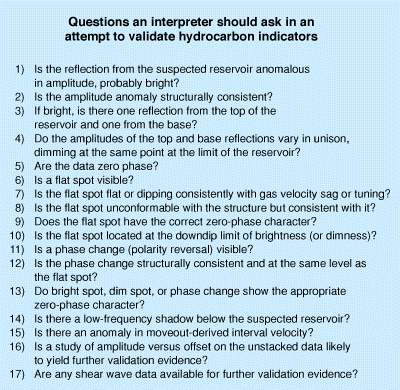1. S. [Geofísica]
Un tipo de anomalía de amplitud sísmica, evento sísmico, o característica de los datos sísmicos, que puede tener lugar en un yacimiento hidrocarburífero. Si bien los "puntos brillantes," como se llama informalmente a los indicadores de hidrocarburos, se pueden originar de numerosas maneras, no en todos los casos indican la presencia de hidrocarburos. Los criterios para diferenciar los indicadores de hidrocarburos verdaderos (a veces denominados HCIs) de otros tipos de anomalías de amplitud son los siguientes:
- variación de la amplitud con el desplazamiento
- puntos brillantes o puntos oscuros en la amplitud, como resultado de las variaciones producidas en la litología y los fluidos intersticiales, que a veces se producen en grupos de yacimientos apilados
- cambio o inversión de la polaridad debido a cambios de velocidad, también conocido como puesta en fase
- concordancia con las estructuras locales
- difracciones que emanan de los contactos de fluidos
- horizonte plano que representa un contacto de fluidos (gas-petróleo o gas-agua), que en ciertos casos también puede mostrar el límite echado abajo del yacimiento
- chimeneas de gas sobre yacimientos con pérdidas de fluidos
- zonas de sombra por debajo de la acumulación
- depresión aparente de velocidad debido a las velocidades más bajas de los hidrocarburos respecto de las rocas
- diferencia de respuesta entre la presión reflejada y la energía de corte.
Los indicadores de hidrocarburos son más comunes en los sedimentos siliciclásticos no consolidados, relativamente modernos, con grandes contrastes de impedancia a lo largo de los límites litológicos, tales como los existentes en el Golfo de México y en el área marina del oeste de África. Un problema persistente en la exploración de indicadores de hidrocarburos es la dificultad que implica diferenciar las acumulaciones de gas y el agua con una baja saturación de gas ("saturación parcial de gas").
Forma alternativa:
punto brillante
Ver:
anomalía de amplitud,
variación de la amplitud con el desplazamiento,
atributo,
difracción,
punto oscuro,
chimenea de gas,
fase,
depresión aparente,
velocidad
